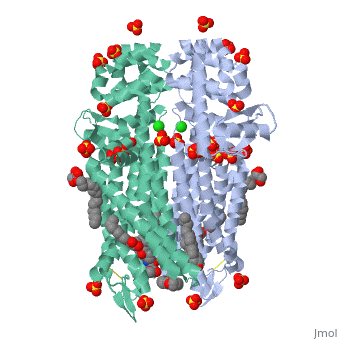4dkl
From Proteopedia
(Difference between revisions)
| Line 1: | Line 1: | ||
| + | |||
==Crystal structure of the mu-opioid receptor bound to a morphinan antagonist== | ==Crystal structure of the mu-opioid receptor bound to a morphinan antagonist== | ||
<StructureSection load='4dkl' size='340' side='right' caption='[[4dkl]], [[Resolution|resolution]] 2.80Å' scene=''> | <StructureSection load='4dkl' size='340' side='right' caption='[[4dkl]], [[Resolution|resolution]] 2.80Å' scene=''> | ||
== Structural highlights == | == Structural highlights == | ||
| - | <table><tr><td colspan='2'>[[4dkl]] is a 1 chain structure with sequence from [http://en.wikipedia.org/wiki/ | + | <table><tr><td colspan='2'>[[4dkl]] is a 1 chain structure with sequence from [http://en.wikipedia.org/wiki/Lk3_transgenic_mice Lk3 transgenic mice]. Full crystallographic information is available from [http://oca.weizmann.ac.il/oca-bin/ocashort?id=4DKL OCA]. For a <b>guided tour on the structure components</b> use [http://oca.weizmann.ac.il/oca-docs/fgij/fg.htm?mol=4DKL FirstGlance]. <br> |
| - | </td></tr><tr id='ligand'><td class="sblockLbl"><b>[[Ligand|Ligands:]]</b></td><td class="sblockDat"><scene name='pdbligand=1PE:PENTAETHYLENE+GLYCOL'>1PE</scene>, <scene name='pdbligand=BF0:METHYL+4-{[(5BETA,6ALPHA)-17-(CYCLOPROPYLMETHYL)-3,14-DIHYDROXY-4,5-EPOXYMORPHINAN-6-YL]AMINO}-4-OXOBUTANOATE'>BF0</scene>, <scene name='pdbligand=CL:CHLORIDE+ION'>CL</scene>, <scene name='pdbligand=CLR:CHOLESTEROL'>CLR</scene>, <scene name='pdbligand=MPG: | + | </td></tr><tr id='ligand'><td class="sblockLbl"><b>[[Ligand|Ligands:]]</b></td><td class="sblockDat"><scene name='pdbligand=1PE:PENTAETHYLENE+GLYCOL'>1PE</scene>, <scene name='pdbligand=BF0:METHYL+4-{[(5BETA,6ALPHA)-17-(CYCLOPROPYLMETHYL)-3,14-DIHYDROXY-4,5-EPOXYMORPHINAN-6-YL]AMINO}-4-OXOBUTANOATE'>BF0</scene>, <scene name='pdbligand=CL:CHLORIDE+ION'>CL</scene>, <scene name='pdbligand=CLR:CHOLESTEROL'>CLR</scene>, <scene name='pdbligand=MPG:[(Z)-OCTADEC-9-ENYL]+(2R)-2,3-BIS(OXIDANYL)PROPANOATE'>MPG</scene>, <scene name='pdbligand=SO4:SULFATE+ION'>SO4</scene></td></tr> |
| - | <tr id='gene'><td class="sblockLbl"><b>[[Gene|Gene:]]</b></td><td class="sblockDat">Mor, Oprm, Oprm1, E ([http://www.ncbi.nlm.nih.gov/Taxonomy/Browser/wwwtax.cgi?mode=Info&srchmode=5&id= | + | <tr id='gene'><td class="sblockLbl"><b>[[Gene|Gene:]]</b></td><td class="sblockDat">Mor, Oprm, Oprm1, E ([http://www.ncbi.nlm.nih.gov/Taxonomy/Browser/wwwtax.cgi?mode=Info&srchmode=5&id=10090 LK3 transgenic mice])</td></tr> |
<tr id='activity'><td class="sblockLbl"><b>Activity:</b></td><td class="sblockDat"><span class='plainlinks'>[http://en.wikipedia.org/wiki/Lysozyme Lysozyme], with EC number [http://www.brenda-enzymes.info/php/result_flat.php4?ecno=3.2.1.17 3.2.1.17] </span></td></tr> | <tr id='activity'><td class="sblockLbl"><b>Activity:</b></td><td class="sblockDat"><span class='plainlinks'>[http://en.wikipedia.org/wiki/Lysozyme Lysozyme], with EC number [http://www.brenda-enzymes.info/php/result_flat.php4?ecno=3.2.1.17 3.2.1.17] </span></td></tr> | ||
| - | <tr id='resources'><td class="sblockLbl"><b>Resources:</b></td><td class="sblockDat"><span class='plainlinks'>[http://oca.weizmann.ac.il/oca-docs/fgij/fg.htm?mol=4dkl FirstGlance], [http://oca.weizmann.ac.il/oca-bin/ocaids?id=4dkl OCA], [http://www.rcsb.org/pdb/explore.do?structureId=4dkl RCSB], [http://www.ebi.ac.uk/pdbsum/4dkl PDBsum]</span></td></tr> | + | <tr id='resources'><td class="sblockLbl"><b>Resources:</b></td><td class="sblockDat"><span class='plainlinks'>[http://oca.weizmann.ac.il/oca-docs/fgij/fg.htm?mol=4dkl FirstGlance], [http://oca.weizmann.ac.il/oca-bin/ocaids?id=4dkl OCA], [http://pdbe.org/4dkl PDBe], [http://www.rcsb.org/pdb/explore.do?structureId=4dkl RCSB], [http://www.ebi.ac.uk/pdbsum/4dkl PDBsum]</span></td></tr> |
</table> | </table> | ||
| + | == Function == | ||
| + | [[http://www.uniprot.org/uniprot/OPRM_MOUSE OPRM_MOUSE]] Receptor for endogenous opioids such as beta-endorphin and endomorphin. Agonist binding to the receptor induces coupling to an inactive GDP-bound heterotrimeric G-protein complex and subsequent exchange of GDP for GTP in the G-protein alpha subunit leading to dissociation of the G-protein complex with the free GTP-bound G-protein alpha and the G-protein beta-gamma dimer activating downstream cellular effectors. The agonist- and cell type-specific activity is predominantly coupled to pertussis toxin-sensitive G(i) and G(o) G alpha proteins, GNAI1, GNAI2, GNAI3 and GNAO1 isoforms Alpha-1 and Alpha-2, and to a lesser extend to pertussis toxin-insensitive G alpha proteins GNAZ and GNA15. They mediate an array of downstream cellular responses, including inhibition of adenylate cyclase activity and both N-type and L-type calcium channels, activation of inward rectifying potassium channels, mitogen-activated protein kinase (MAPK), phospholipase C (PLC), phosphoinositide/protein kinase (PKC), phosphoinositide 3-kinase (PI3K) and regulation of NF-kappa-B. Also couples to adenylate cyclase stimulatory G alpha proteins. The selective temporal coupling to G-proteins and subsequent signaling can be regulated by RGSZ proteins, such as RGS9, RGS17 and RGS4. Phosphorylation by members of the GPRK subfamily of Ser/Thr protein kinases and association with beta-arrestins is involved in short-term receptor desensitization. Beta-arrestins associate with the GPRK-phosphorylated receptor and uncouple it from the G-protein thus terminating signal transduction. The phosphorylated receptor is internalized through endocytosis via clathrin-coated pits which involves beta-arrestins. The activation of the ERK pathway occurs either in a G-protein-dependent or a beta-arrestin-dependent manner and is regulated by agonist-specific receptor phosphorylation. Acts as a class A G-protein coupled receptor (GPCR) which dissociates from beta-arrestin at or near the plasma membrane and undergoes rapid recycling. Receptor down-regulation pathways are varying with the agonist and occur dependent or independent of G-protein coupling. Endogenous ligands induce rapid desensitization, endocytosis and recycling. Heterooligomerization with other GPCRs can modulate agonist binding, signaling and trafficking properties. Involved in neurogenesis. Isoform 9 is involved in morphine-induced scratching and seems to cross-activate GRPR in response to morphine.<ref>PMID:10842167</ref> <ref>PMID:16682964</ref> <ref>PMID:21422164</ref> <ref>PMID:22437502</ref> <ref>PMID:7797593</ref> <ref>PMID:9037090</ref> | ||
<div style="background-color:#fffaf0;"> | <div style="background-color:#fffaf0;"> | ||
== Publication Abstract from PubMed == | == Publication Abstract from PubMed == | ||
| Line 16: | Line 19: | ||
From MEDLINE®/PubMed®, a database of the U.S. National Library of Medicine.<br> | From MEDLINE®/PubMed®, a database of the U.S. National Library of Medicine.<br> | ||
</div> | </div> | ||
| + | <div class="pdbe-citations 4dkl" style="background-color:#fffaf0;"></div> | ||
==See Also== | ==See Also== | ||
| Line 22: | Line 26: | ||
*[[Mu Opioid Receptor Bound to a Morphinan Antagonist|Mu Opioid Receptor Bound to a Morphinan Antagonist]] | *[[Mu Opioid Receptor Bound to a Morphinan Antagonist|Mu Opioid Receptor Bound to a Morphinan Antagonist]] | ||
*[[Opioid receptor|Opioid receptor]] | *[[Opioid receptor|Opioid receptor]] | ||
| + | *[[ÃÂ Opioid Receptors|ÃÂ Opioid Receptors]] | ||
== References == | == References == | ||
<references/> | <references/> | ||
__TOC__ | __TOC__ | ||
</StructureSection> | </StructureSection> | ||
| - | [[Category: | + | [[Category: Lk3 transgenic mice]] |
[[Category: Lysozyme]] | [[Category: Lysozyme]] | ||
[[Category: Granier, S]] | [[Category: Granier, S]] | ||
Revision as of 07:53, 20 June 2016
Crystal structure of the mu-opioid receptor bound to a morphinan antagonist
| |||||||||||

